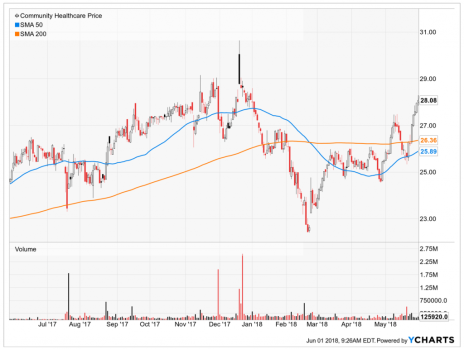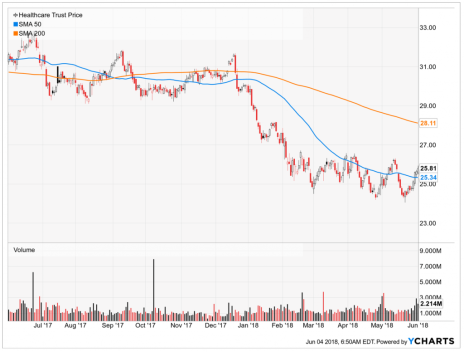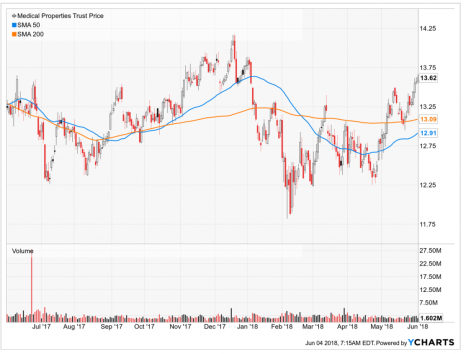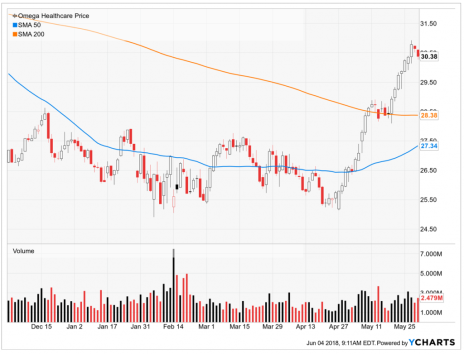Real Estate Investment Trusts, or REITs, are a great source of regular income for retirees and other investors who live off the income from their investment portfolio.
REITs can own all sorts of real estate, from convenience stores to forests to apartment buildings.
Healthcare REITs are REITs that own doctors’ offices, hospitals, assisted living facilities, and other medical buildings. Because the healthcare industry in the U.S. is booming, and because properties are usually leased to healthcare providers under long-term leases, healthcare REITs tend to have very stable, predictable income as well as good growth prospects.
The best healthcare REITs are those with a track record of stable income and distributions, manageable debt, an experienced management team, and, if possible, a profitable industry niche. Based on those and other criteria, here are my current picks for the five best healthcare REITs to buy right now:
Healthcare REIT #1: Community Healthcare Trust (CHCT)
Community Healthcare Trust owns all sorts of healthcare facilities in non-urban areas, mostly in the mid-west, the South and Texas.
The company’s buildings include clinics, medical offices, mental health facilities, ambulatory surgery centers and specialty properties like dialysis and endoscopy centers.
The company currently has investments in 89 properties, and is adding a few new properties to its portfolio every quarter, mostly through acquisitions. Management chooses to focus on non-urban markets in part because there’s less competition there, so acquisition prices are lower.
While the future is bright, the past is short: Community Healthcare Trust is a new company, founded in March 2014 by industry veteran Timothy Wallace.
The REIT came public in May 2015 and paid its first dividend that August. So the company’s dividend history—and all other types of history—are thin.
However, what track record CHCT has is good.

Get My Free Report Now

Get My Free Report Now

Get My Free Report Now

Get My Free Report Now
Funds from Operations (FFO), a widely used measure of REIT cash flow, have increased nearly every quarter since the IPO. In the latest quarter, FFO per share rose by 5%. Analysts expect annual growth of about 17% this year and 19% next year. In part because the company is relatively new, CHCT has the lowest debt of any of the health care REITs I track (by far).
And since August 2015, the company has increased its dividend by 0.25 cents per quarter every quarter, or by about 3% per year, for a current yield of about 5.8%.
Technically, volume is light, but I like the stock’s three higher lows since February—two at the 50-day line—and recent breakout.
Healthcare REIT #2: Physicians Realty Trust (DOC)
Physicians Realty is another relatively new healthcare REIT. The company came public in 2013, and spent the next four years or so on an acquisition spree, increasing the size of its portfolio by a factor of 20.
The company now owns 265 properties, mostly medical office buildings in large metropolitan areas. About 85% of DOC’s buildings are on a hospital campus or affiliated with a hospital, and tenants are mostly large healthcare systems. Buildings often include several different types of medical offices, but DOC considers orthopedics, surgery and oncology its specialties (the Baylor Cancer Center in Dallas is one flagship property.)
Over 96% of DOC’s portfolio is currently leased, with an average of 8.3 years left on the leases. FFO per share has increased every year since DOC came public, as well as in each of the last four quarters. Debt to equity is about 0.60, significantly lower than the industry average.
The company’s management team includes a former U.S. Secretary of Health and Human Services and veterans from other healthcare REITs. The dividend payout ratio based on FFO is about 85%, and DOC currently yields about 6.0%.
However, the stock has been underperforming peers over the past year.
The strength of the medical office building market is partly to blame; DOC’s acquisitions are expected to slow significantly in 2018 due in part to rising property prices (leverage is also approaching the upper end of management’s target range). Management will sell a few smaller buildings to free up cash for acquisitions of higher-quality assets, and rent increases built into existing leases will contribute moderately to revenue growth.
However, the slower growth expectations have meant DOC has been underperforming peers in recent months.
On the flipside, that means the stock is cheap, especially for long-term investors.
Healthcare REIT #3: Healthcare Trust of America (HTA)
Arizona-based Healthcare Trust of America is another medical office REIT. Founded in 2006, the REIT came public in June 2012. Funds from Operations (FFO) per share have risen almost every year since (they dipped slightly in 2015). Revenue has increased every year.
HTA’s properties are concentrated in 20-25 “key markets,” mostly growing cities like Boston, Hartford, Miami, Pittsburgh, Indianapolis, Atlanta, Houston, Dallas and Phoenix. The company completed a $2.7 billion acquisition in 2017 that increased the size of their portfolio by 35%, making HTA the largest owner-operator of medical buildings in the U.S.
Same-store sales growth is about 3%, slightly above the industry average. In this industry same-store sales growth is fueled mostly by rent increases, but HTA has also been expanding its property management services (snow removal, for example), creating additional revenue streams. HTA’s leverage is reasonable; the company’s current debt-to-equity ratio is currently 0.85, relatively low for the industry.
HTA has increased its dividend in each of the last five years, by an average of 16% per year, and now yields about 5%. The current dividend payout ratio based on FFO is just over 80%.
HTA hasn’t recovered from the first-quarter REIT selloff yet, but put in a solid-looking bottom around 24.50 over the past two months.
Healthcare REIT #4: Medical Properties Trust (MPW)
Medical Properties Trust mostly owns hospitals, including rebab hospitals, long-term acute care hospitals and regional and community hospitals.
In addition to their U.S. portfolio, the company also owns a bunch of rehab clinics in Germany and a handful of properties in Italy, the U.K. and Spain. Rather than specializing in one type of market, MPW focuses on hospitals that are essential to their communities.
MPW also identifies as a “socially responsible company,” and is dedicated to creating a supportive, non-discriminatory work environment and supporting a variety of charities and community organizations.
MPW has bounced back nicely after the first-quarter REIT selloff, and could surpass its YTD high any day.
The stock’s strength is supported by strong earnings growth estimates. FFO is expected to rise by 13% this quarter and 6% this year, while revenues are expected to increased 23% this quarter and 16% this year. Both estimates have risen in recent weeks.
MPW’s yield is also attracting investors: at current prices, MPW yields about 8.0%. The company has paid dividends since 2005, and has increased the dividend every year since 2013. Over the past five years, the dividend increases have averaged about 5% annually. And in the latest quarter, MPW’s dividend payout ratio as a percentage of FFO was only 70%, so there’s still plenty of room for further growth.
Healthcare REIT #5: Omega Healthcare Investors (OHI)
Rounding out the list is a riskier idea—but the stock yields 9%.
Omega Healthcare Investors owns assisted living facilities and nursing homes. Omega currently own 963 long-term care facilities, spread across 41 states (as well as one facility in the U.K.)
The industry is growing steadily as the U.S. population ages, but declining Medicare reimbursement rates have presented a challenge in recent years. That plus other factors (rising labor costs and changing hospital referral practices among them) contributed to big declines in Omega’s FFO over the past two years. FFO is expected to decline again this year, dragged down by a 5% drop in revenues.
However, revenues and FFO are both expected to start recovering next year, with analysts currently anticipating growth of about 3% in both. Estimates have risen following Omega’s first quarter results, which beat expectations on both fronts.
The stock has also advanced following the report, bouncing to its highest level since October in just over one month.
Because of the unfavorable industry trends, OHI is still a riskier bet than the other healthcare REITs above (they also have a somewhat higher debt load).
However, the company does have a strong dividend history. Omega has paid dividends since 1992 and has increased the dividend every year since 2003, often multiple times per year. Over the past five years, the company has increased the dividend by an average of 7% per year.
For investors with higher risk tolerance, OHI could be an interesting, earlier-stage investment.
If you want to know which of these REITs is my top pick right now, all you have to do is take a trial subscription to Cabot Dividend Investor, where I just added one of these healthcare REITs to our portfolio only a week ago. Click here to join.








